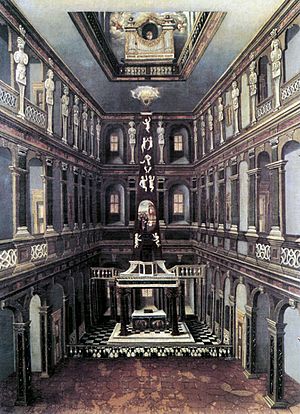Herz und Mund und Tat und Leben, BWV 147a facts for kids
Quick facts for kids Herz und Mund und Tat und Leben |
|
|---|---|
| Church cantata by Johann Sebastian Bach | |

Schlosskirche in Weimar
|
|
| Related | basis for BWV 147 |
| Occasion | Fourth Sunday in Advent |
| Composed | 1716: Weimar |
| Movements | 6 |
| Vocal | SATB choir and solo |
| Instrumental |
|
Herz und Mund und Tat und Leben (which means "Heart and mouth and deed and life") is a special piece of music called a cantata. It was written by the famous composer Johann Sebastian Bach. This cantata is known as BWV 147.1, or BWV 147a.
Bach created this music in Weimar in 1716. He wrote it for a specific church day, the fourth Sunday in Advent, which was December 20th that year. We're not sure if it was actually performed back then. Later, in 1723, Bach made a longer version of this work. It became the well-known cantata Herz und Mund und Tat und Leben, BWV 147.
Bach's Time in Weimar
In 1714, Bach got an important job in Weimar. He became the concertmaster for the dukes of Saxe-Weimar. This meant he was in charge of composing new music, especially cantatas, for the palace church (called Schlosskirche). He had to write a new cantata almost every month.
Bach probably wrote this cantata in 1716 for the fourth Sunday of Advent. The church readings for that day came from the Epistle to the Philippians and the Gospel of John. The words for the cantata were written by Salomo Franck, who was a poet at the court. His text was part of a collection published in 1717.
Bach's boss, Drese, passed away in December 1716. Bach seemed eager to show his skills by writing cantatas for three Sundays in a row, including this one. However, he soon found out that Drese's son would get the top music job, not him. Because of this, Bach stopped working on these cantatas. He even left this cantata unfinished after the first part. He didn't write another cantata for Weimar after that.
Music and Instruments
This cantata was written for four solo singers: a soprano, an alto, a tenor, and a bass. It also included a four-part choir. Sadly, the original music for this cantata is now lost. So, we don't know exactly which instruments Bach used. But it was probably similar to the later version, BWV 147.
The cantata has six different parts, called movements:
- Chorus: Herz und Mund und Tat und Leben (Heart and mouth and deed and life)
- Aria: Schäme dich, o Seele nicht (Don't be ashamed, O soul)
- Aria: Hilf, Jesu, hilf, dass ich auch dich bekenne (Help, Jesus, help me to confess you too)
- Aria: Bereite dir, Jesu, noch heute die Bahn (Prepare the way for yourself, Jesus, even today)
- Aria: Laß mich der Rufer Stimme hören (Let me hear the voice of the caller)
- Chorale: Dein Wort laß mich bekennen (Let me confess your word)
The first part, the opening chorus, is very detailed. It talks about how Christians should be like John the Baptist and share their faith with their whole being. This movement starts with a grand instrumental section. A trumpet plays a fanfare, and the string instruments answer it. The main musical idea, called a ritornello, is played with the singers joining in. It then repeats at the end.
The cantata has four arias, which are songs for a single singer. The first aria is for the alto singer, possibly with a viola playing a special solo part. The third movement is an aria for the tenor with a continuo, which is a bass instrument and a keyboard. The fourth movement is a soprano aria with a solo violin playing along.
The fifth movement is a bass aria. It refers to John the Baptist again, who spoke about the prophet Isaiah. This part features a trumpet and strings playing with the bass singer, much like the opening movement.
The last movement is a chorale, which is a hymn tune. The poet Franck only wrote the first two lines for this. The rest of the words were found in a hymn book from that time.
When Bach made the longer version of the cantata, he likely used the same opening movement. He also used the first aria as movement 3, the second as movement 7, the third as movement 5, and the fourth with new words as movement 9. The final chorale from this earlier version was not used in the later work.
See also
 In Spanish: Herz und Mund und Tat und Leben, BWV 147a para niños
In Spanish: Herz und Mund und Tat und Leben, BWV 147a para niños

